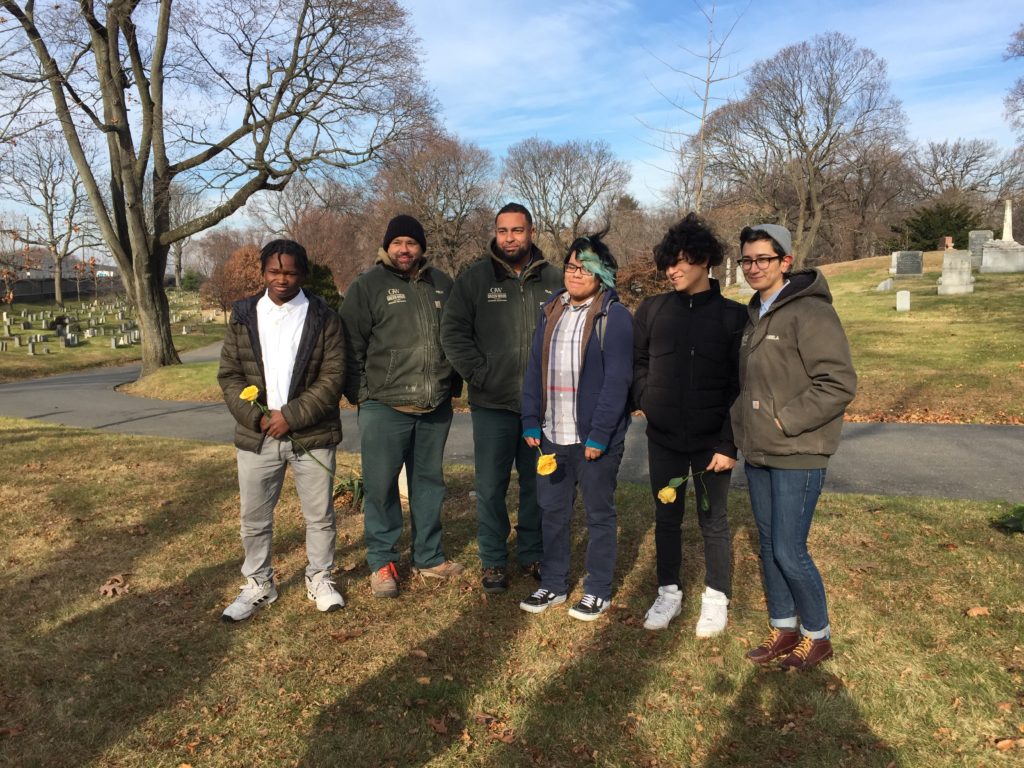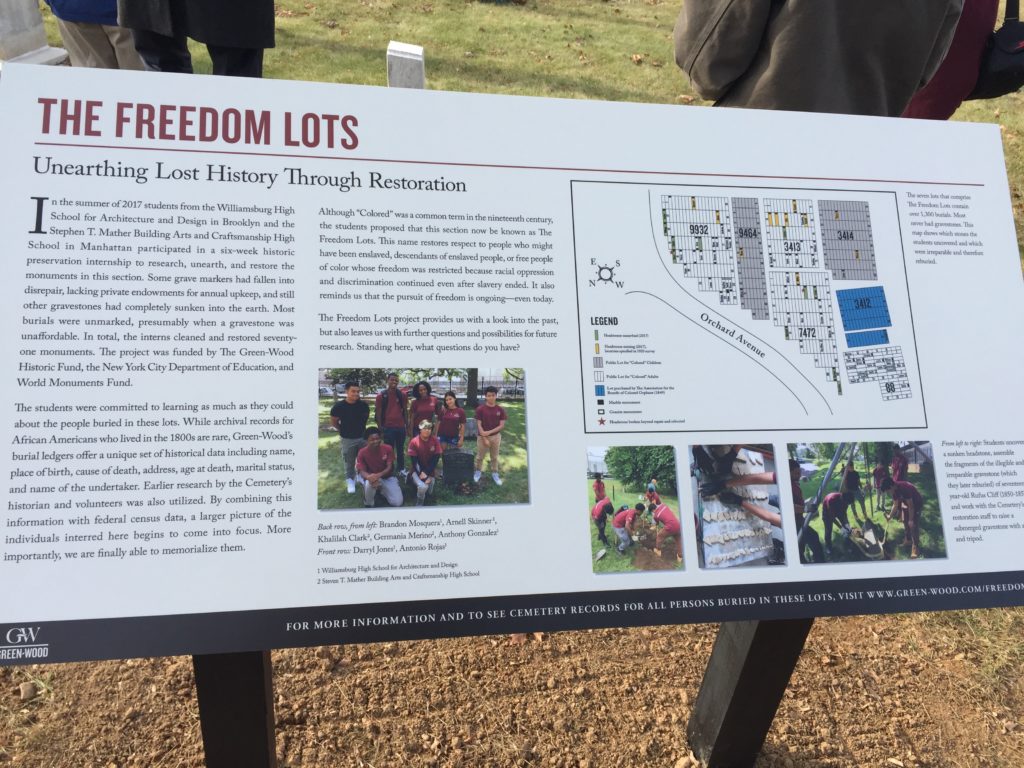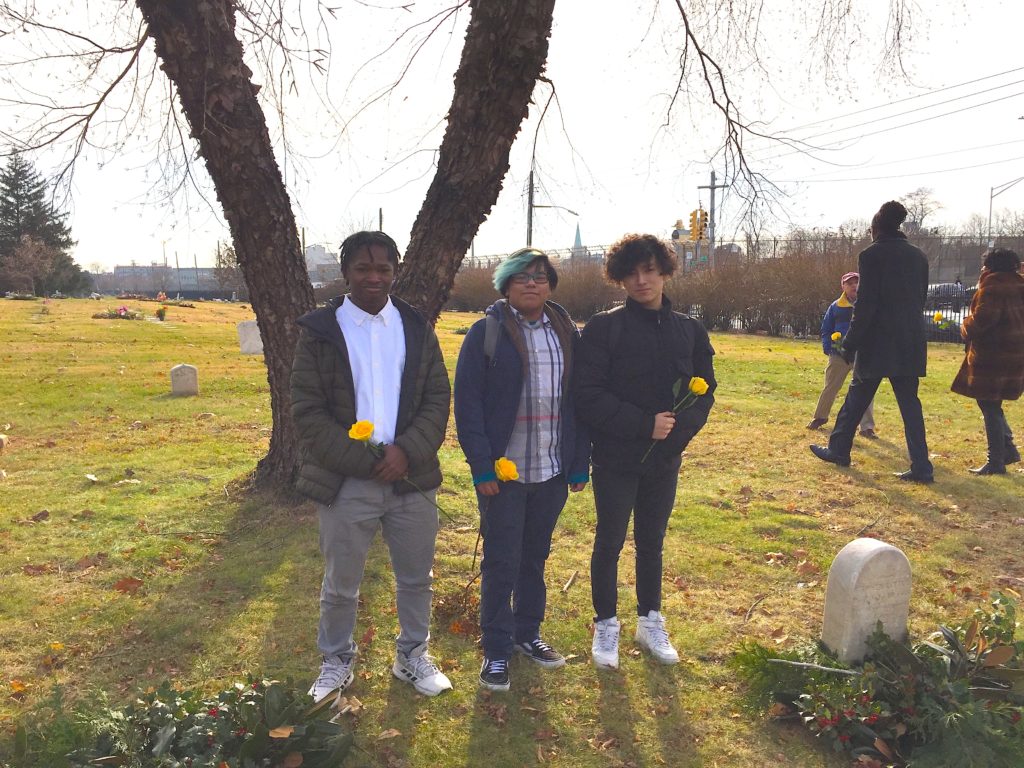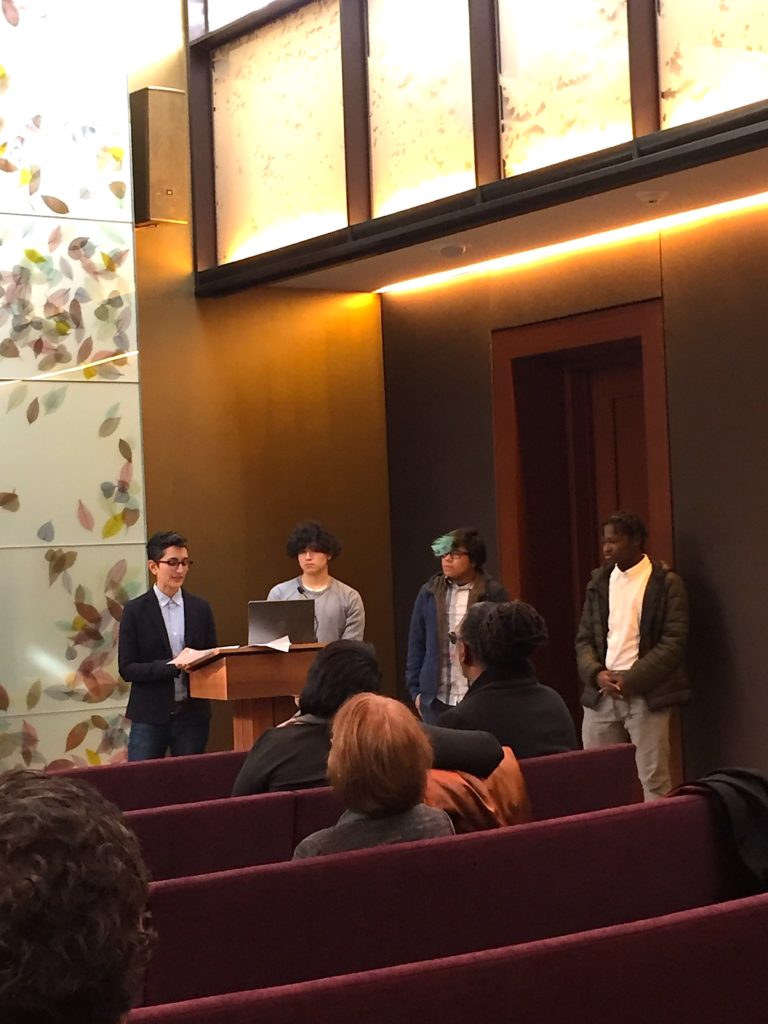
As one of WHSAD’s original internship partners, Green-Wood Cemetery in Brooklyn has long been a place where students have learned about history, preservation, and restoration. Since 2009, WHSAD students have participated in summer internships at the cemetery, learning how to restore monuments and working with different materials. In the summer of 2017, the WHSAD interns had the unique experience of helping to research and designate the Freedom Lots — public lots that are the final resting places of a number of African-Americans, but about which little was known. Students not only helped unearth buried monuments and restore them, they also researched the individuals and came up with the new name for the previously-known “colored lots”.
-Emily Wilson, WHSAD’s Work-Based Learning Coordinator

Thank you to all the staff at Green-Wood, in particular Green-Wood gravediggers, Gustavo Padilla and Felix Hernandez, and Neela Wickremesinghe, Green-Wood’s Manager of Restoration and Preservation. These individuals were integral in assisting WHSAD students during their internships and participation in the “Freedom Lots” restoration process.
In the following narratives, participating students provide their thoughts regarding their experiences.
Working at the Green-Wood Cemetery was truly an honor for me. I learned a tremendous amount more about this country, Brooklyn, society at the time of the cemetery’s hey-day, and about the cemetery itself. It helped make me more professional, both physically and mentally stronger, and also helped shaped me as a growing adult. These experiences have also helped me explore new careers related to my field while also making me aware of how those professions affect society.
I had always known about the Green-Wood Cemetery but had no idea about how significant it is to this city and country. Sometimes my family and I would ride alongside it to get to my father’s job across 36th St, his depot, and on other occasions like shopping or road trips out-of-town. Little did I know when I was smaller thenthat I would have the honor of working at such a significant place in Brooklyn. I have learned its tremendous impact on the city and how it directly inspired the creation of both New York City’s Central and Prospect parks and its critical role in the American Revolution. But perhaps the most significant focus of this essay is its role in historical society. This includes the story of the now reformed “Freedom Lots”.
As we all know, or should know, the roots of slavery and its impact runs deep in this country. As great a nation as America is, we must never forget the evils of and scars left from slavery. The Green-Wood Cemetery reflects these times in a section once known as the “Black” or “Colored Plots”. These racially segregated plots were designated to slaves or former slaves and their descendants of the time. They were often poorer than many of the other residents of the cemetery who could afford more durable headstones and grand estate-like mausoleums of the affluent class. The historical social as well as economic segregation of this country can clearly be seen throughout the cemetery. But newer generations of workers at the cemetery, like full time professionals and interns like me, have helped right these wrongs of our country’s past.
The “Colored Plots”, as they were formerly called, were the final resting place of about over 120 African American slaves and former slaves. These plots were usually in great disrepair, as the headstones were often tilted, spotted with wild and stray animals’ waste that live in and around the cemetery, cracked in pieces or totally disintegrated. And in my opinion, the context of the situation was emphasized by the screeching of the D train in the nearby train yards, which reflected the often disregard from city officials as well as engineers and planners for minorities while this city was being built back in the day.

Our team of summer interns and professionals, led by Neela, put our best efforts forward into restoring the plots to a more presentable and honorable state. We dug out and reset headstones using shovels and tripods, lifting up headstones in decent condition to their former glory. We washed dirty headstones and monuments with a special biological soap called D-2 to remove greenery growing on them as well as dirt. We also elevated them to higher grounds with new dirt and topsoil as well as flowers to beautify the area. A plaque is also placed at the front center of the plots to properly memorialize the site.
I have learned a great deal from my experiences of working at the Green-Wood Cemetery in the summers of 2017 and 2018. I have also gotten my feet wet working and professional world. I am eternally grateful for this opportunity and recommend working here or even just visiting to any and everyone to explore and experience this wonder.
-Darryl Jones, WHSAD Senior
It was the summer of 2017. I had a paid internship at a place named The Green-Wood Cemetery. I had never heard of it, didn’t even know where it was located or that it existed. All I saw of it was six grueling weeks of manual labor under the hot summer sun. What it turned out to be was a lesson in history and legacy, a new perspective of an otherwise solemn site.
From the start, it wasn’t all about manual labor. The first few weeks were about recording existing graves and lots, knowing to distinguish the types of headstones that exist and whether the material they were made out of was granite or marble.We were informed of the layout of the cemetery, why it is the way it is, the history and what it inspired.
It was the weeks when we started to do manual labor that obviously taught us the most, not just literally but how certain things-whether physically or emotionally-are easy to influence and produce actions. When we first arrived to site of the then named “Colored Lots”, it was an eye-sore compared to the rest of the cemetery, which was full of beautiful colorful hills, lively lakes, unique mausoleums, and towering obelisks.
This relatively small lot was left neglected since the nineteenth century, and it showed. With little to no headstones present and those that were present were not recognizable-already halfway into the ground, covered in dirt, chipped and eroded due to the elements. The majority of those buried in the colored lots were African-American, and many of those buried had been free, but though they were free that did not mean they were treated equally and with respect; racism and segregation followed them even to their final moments. The lot was a small piece of land that was left in time.

My despair of waking up and traveling to work became determination and sense of responsibility to restore the wrongs and injustices that the forgotten have faced, to bring those lost in history into the light. Over the rest of the weeks which we worked, we uncovered, restored, reset, and cleaned headstones that had no support, no foundation, and no care or treatment towards them. There were a few that were unfixable, pieces of marble shattered due to the roots of nearby trees decimating the headstones.
An event during the final weeks showed the impact and the reason for doing what we had done: the Charlottesville riots showed the influence and social impacts that a statue or monument has on people, what that monument carried and represented for people. What we had accomplished, what we had sweated and tired over revealed that what we were doing mattered even more than we had initially thought. Although these headstones were forgotten for over a century, their importance was still relevant, resonated and showed that issues have not been solved and many still face injustice today. The lot has since then been recovered and renamed to the “Freedom Lots,” as we, the interns, felt the name fit best with what the lot itself is.
-Antonio Rojas, WHSAD Senior
At my time at Green-Wood, I had a very interesting experience. Since I already had experience working here, I already knew the basics and started to teach some of the new interns at the site what they needed to know in order to succeed.
During the first week, nothing really major occurred. We were being introduced to the faculty members and some of the guidelines that we had to follow. We started to really get down to business in the second week. We were being introduced to a new GPS system that helped us locate existing headstones around the area. We were also taught new techniques to dig out these buried headstones and how not to injure ourselves doing it. Most of the interns with whom I was working have been my friends for years, so it was a friendly environment from the start, and it only got better over time.
Throughout the five weeks working at Green-Wood, we were constantly working our butts off to reset, find, and dig out headstones. It was a lot of labor factoring in that the temperatures were hovering around 80+ degrees on a daily basis. Our group got so much done in a short amount of time, and I couldn’t be happier for us. I wasn’t there for the last days of the internship, but our group had to prepare a PowerPoint presentation about all the work that we did over the past five weeks. Overall, the job was a great experience, and I was very happy to be a part of that environment, even if it was for a short amount of time.
-Anthony Gonzalez, WHSAD Senior
